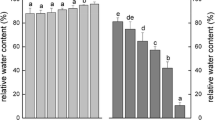Abstract
The capability of mature cotton plants (Gossypium hirsutum L.) to adjust to progressive drying of their root zone by promoting root growth to adjacent wetted zones, and the implications of this process on irrigation design were investigated. Field grown plants that developed shallow root systems in response to a drip irrigation management of daily, surface soil wettings were exposed 85 days after emergence (DAE), while in the flowering stage, to a sudden change in water distribution in the form of deep soil wetting (DSW) followed by termination of irrigation. The shallow rooted plants (SRP) failed to respond to further surface soil wetting and the progressive drying of the profile by rapid root growth to the deeper-wetted zones; consequently, the SRP suffered from water deficiency for at least two weeks, evidenced by a gradual decrease in their leaf water potential (Lψw). Potted plants responded similarly. Daily irrigations of the pot surface with water amounts similar to those lost by evapotranspiration led to the development of a system in which most of the roots and available water became concentrated at the pot's upper section. A transition to irrigation from the bottom of the pot led to a reversed soil-water content gradient and failed to promote rapid root spreading to the deeper-wetted layers, in spite of the accelerated drying of the upper zone. The slow deepening of the root system was accompanied by water-stress symptoms as indicated by a considerable reduction in dry matter production. The root shoot ratio in these plants was not much greater than in non-stressed plants in which the surface wetting was continued. This indicated that preferential root growth relative to the shoot did not occur in response to the progressive drying of the shallow root zone. Rewetting of the root zone after a long period of soil water deficiency failed to promote rapid recovery of the root system in the form of root regrowth in this zone. It was concluded that the capability of mature cotton plant roots to adjust their growth to large changes in water distribution in the soil, is slow and that this should be taken into account when determining an irrigation regime in which the depth at which water is applied is changed during the growing season.
Similar content being viewed by others
References
Burch GJ, Smith RGG, Manson WK (1978) Agronomic and physiological responses of soybean and sorghum crops to water deficits. II. Crop evaporation, soil water depletion and root distribution. Aust Plant Physiol 5:169
Carmi A (1985) Effects of root zone volume and plant density on the vegetative and reproductive development of cotton. Field Crop Res 13:25
Carmi A, Plaut Z (1982) A new agrotechnique for control of cotton growth and earliness of yield based upon drip irrigation system. Belt Cot Prod Res Con, Las Vegas, p 58
Carmi A, Plaut Z (1988) Double cropping system (cotton wheat) based on frequent drip irrigation and control of the root zone system. In: Rymon D (ed) Optimal Yield Management. Avebury, p 165
Carmi A, Plaut Z, Heuer B, Grava A (1992) Establishment of shallow and restricted root systems in cotton and its impact on plant response to irrigation. Irrig Sci 13:87
Klepper B, Taylor HM, Huck MG, Fiscus EL (1973) Water relations and growth of cotton in drying soil. Agron J 65:307
Mason WK, Rowse HR, Bennie AT, Kaspar TC, Taylor HM (1982) Responses of soybeans to two row spacing and two soil water levels II. Water use, root growth and plant water status. Field Crop Res 5:15
Mayaki WC, Stone LR, Teare ID (1976) Irrigated and nonirrigated soybean, corn and grain sorghum root systems. Agron J 68:532
Newell RL, Wilhelm WW (1987) Conservation tillage and irrigation effects on corn root development. Agron J 79:160
Robertson WK, Hammond LC, Johnson JT, Boote KJ (1980) Effects of plant water stress on root distribution of corn, soybeans and peanuts in sandy soil. Agron J 72:548
Taylor HM, Klepper B (1974) Water relations of cotton. I. Root growth and water use as related to top growth and soil water content. Agron J 66:584
Author information
Authors and Affiliations
Additional information
Contribution from the Agricultural Research Organization, Volcani Center, Bet Dagan, Israel; No. 343-E, 1992 series
Rights and permissions
About this article
Cite this article
Carmi, A., Plaut, Z. & Sinai, M. Cotton root growth as affected by changes in soil water distribution and their impact on plant tolerance to drought. Irrig Sci 13, 177–182 (1993). https://doi.org/10.1007/BF00190033
Received:
Issue Date:
DOI: https://doi.org/10.1007/BF00190033




